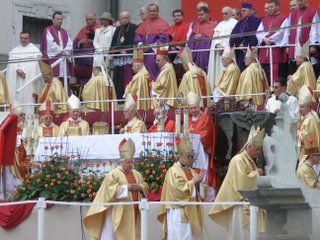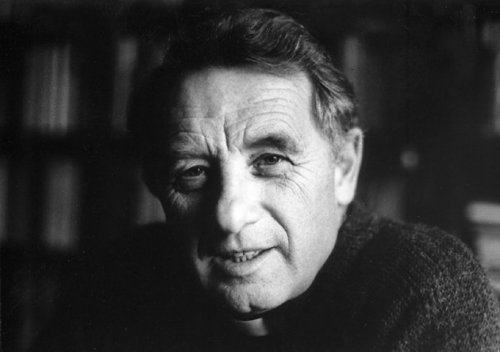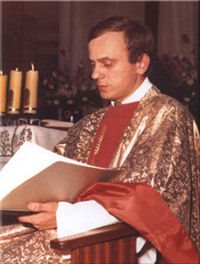
Lots of Bishops and Cardinals...yay!
I cannot believe that time is passing by so fast here. It seems as if I was just in Rome for Easter, and then was with George Weigel here in Krakow, but those events were almost a month ago. In fact, the Church celebrated the Resurrection a month ago, tomorrow!
Time seems to really be flying by—especially with the end of Notre Dame’s school year, and graduation only a few days away, for all of my friends back home, “under the Dome.” To those seniors who will be graduating, know that you’re all in my prayers and in my thoughts, as I myself am nearing final exams, which linger in the future deceptively distant future!
In his famous poem, Stanislaw, the poet Karol Wojtyla writes:
Stanislaw may have thought: my word will hurt and convert you,
You will come as a penitent to the cathedral gate,
Emaciated by fasting, enlightened by a voice within,
To join the Lord’s table like the prodigal son.
The Word did not convert, the blood will:
Perhaps the bishop had no time to think,
Let this cup pass from me.
Reflecting here deeply on the martyrdom of St. Stanislaw, Karol Wojtyla reflected upon the deep and painful reality of the sufferings of Poland throughout the ages. The Metropolitan Archbishop of Krakow reflects on the legacy of his predecessor, the main patron of Poland, and a foundation of Polish Catholicism throughout the ages.
A sword falls on the soil of our freedom;
Blood pours onto the soil of our freedom;
And which weighs more?
Known for his deep devotion to St.Stanislaw, whose place of martyrdom our archbishop and poet would visit quite often, it was here that he deepened his understanding of the meaning and the price of freedom. Each year, he led the St. Stanislaw Procession through the streets of Krakow to Skalka, the Church of St. Michael the Archangel, where the ancient Bishop of Krakow was martyred by Boleslaw the Bold, while saying Mass. It was on the feast day of his holy predecessor that Karol Wojtyla would preach homilies against the regime’s persecution and squelching of human rights. Just as the bishop of old had paid with his life for his faith, and for the true freedom that living the divine moral law brings, so he encouraged the modern Poles to “not be afraid” to stand up for the Truth, for true freedom can only be found in the Truth.
Yesterday, I had the blessed opportunity to attend this year’s St. Stanislaw Procession, which was moved from the feast of the bishop, to the Fifth Sunday of Lent. Arriving at the foot of Wawel Hill around 9:00 a.m., I was surprised by the number of people already processing by—representatives of schools, traditional guilds, government representatives, and parishes. Life-size, and larger-than-life size statues of Mary and the saints made their way past me, as I gazed with awe and wonder at some of the traditional and official costumes. The Order of the Holy Sepulcher processed by in its traditional capes, accompanied with representatives of various Krakow brotherhoods, some which donned traditional Cracovian dress-the long blue overcoat, the white blouse, and feathered-hats, which are very good representations of the traditional Polish noble dress of the 17th century. After the procession of guilds and associations, a virtual “parade of nuns” processed by (our famous “nun parade” at Notre Dame during last year’s Eucharistic Procession pales in comparison)! There were Carmelites, Dominicans, Franciscans, and many other sisters—close to a thousand, by my estimates! Following them, were representatives of the various male orders in Krakow, such as the Dominicans, Franciscans, Benedictines, Carmelites, Bernardines, Capuchins, Jesuits, etc. You name the order, they were there! After this procession of the Church militant, there came the Church Triumphant—huge gold and silver reliquaries of the patron saints of Poland and Krakow. Various orders carried their patron saints. Taking part in the procession were St. Hyacinth, the friend of St. Dominic, who brought the Dominicans to Poland; Saint Jadwiga, the Queen of Poland and wife of Grand Duke Jagiello; Saint Brother Albert, a nineteenth century Polish saints, and founder of the Albertine sisters and brothers; St. John Cantius, the professor and saint of the Academy of Krakow; St. Jozef Bilczewski, the professor of the Jagiellonian University, and archbishop of Lwow, who was canonized in October 2005 by Pope Benedict XVI. At the end of the procession, of course, were the relics of St. Stanislaw, the Cracovian “proto-martyr.”
At the end of the procession of the Church Triumphant, finally came the priests, bishops, archbishops, and cardinals of Poland! In attendance were Cardinal Dziwisz of Krakow, Cardinal Macharski of Krakow, Primate Jozef Glemp, the Metropolitan Archbishop of Warsaw-Gniezno, and Primate of Poland, Cardinal Gulbinkiewicz, the Archbishop of Wroclaw, and Cardinal Marian Jaworski, himself a good friend of Karol Wojytla, the former President of the Pontifical Academy in Krakow, and now the Metropolitan Archbishop of Lwow. Not to even mention Archbishop Kowalczyk, the papal nuncio, and a host of other Polish bishops, from throughout the entire country!
The procession followed the ancient “path of King Boleslaw,” retracing his steps from Wawel Hill to the Church where St. Stanislaw was martyred. Walking in the procession was an awesome and overwhelming experience. This was the very same procession that Cardinal Karol Wojtyla, Cardinal Adam Sapieha, and the many other famous bishops of Krakow had walked throughout the centuries. Walking the path was like walking through time, recollecting the death and life of the saints. Nova et vetera, ever ancient, ever new, I think, may be the only way to describe my experience. I will go down into the chronicles of time as one of the hundreds of thousands of people who have come together to worship and celebrate the death and glorious witness to the faith of such a great saint. Here, the laity came together with the princes of the Church—making the communion of saints so much more tangible.
The Mass was celebrated outside, in front of the quaint, Baroque church that is now built on the spot of the martyrdom. The altar had as a backdrop a huge Polish flag, in which was hung an image of Our Lady of Czestochowa—the very same one which adorned the altar during the celebration of the 900th anniversary of the martyrdom of St. Stanislaw, during his first pilgrimage here in 1979, as Pope John Paul II. “Remain strong in the faith,” the motto on the backdrop reminded us, referring to both the witness of St. Stanislaw and St. Archbishop Bilczewski, and alluding to the theme of the upcoming pilgrimage of the Holy Father to Poland. Primate Glemp gave an amazing and powerful, direct homily about the dangers of the modern ideologies of secularism and consumerism. “Was this just a conflict between two personalities?” asked the cardinal, “between a stubborn bishop and a prideful king? Or is there something deeper here? Was it just about the conflict and tensions between the Church and the State? No, because we see that the two can co-exist side-by-side, and work for the common good.” Then, there must be something more behind the bloody murder of the bishop by the king, the cardinal reminded us. “This conflict was a conflict about the Truth, and the painful reality that the Truth requires action and needs to be defended.” Throughout the history of Poland, there were numerous examples of unjust regimes and people who persecuted the Truth—the Swedes during the “deluge” of the 17th century, Hitler and Stalin in the not-so-distant past. “But who is the enemy now? Can the enemy only be a person, or a group of people? Or can it also be an ideology—an ideology which appears positive on the outside, but is in its deepest core an ideology of an anti-Truth?” The cardinal blasted the modern and often-heard (and often debated) terms of “freedom, tolerance, and justice.” It is precisely behind such terms that evil can lurk, presenting itself as good, and taking many people along with it. Now, more than ever, Poland must stand true to her Christian past, and to live with the bravery and courage of St. Stanislaw, who was willing to put his life on the line by reminding the king about the immorality of his actions.
After the incredible Mass and homily, the procession began its way back to the seat of the Polish kings and bishops, Wawel Cathedral—only to be interrupted by a German-accented voice, speaking in Polish, “I greet all of the Poles gathered here today. Yesterday marked the 25th anniversary of the assassination attempt on our beloved John Paul II, who was saved by the guiding hand of Mary…” Yes, Pope Benedict once again showed his proficiency and newly-learned skill of speaking Polish, by addressing the Poles on St. Peter’s square, and linking to Krakow via satellite, encouraging Poles to remain faithful to the same Mother that had protected this nation throughout the ages of history. I don’t know how this happened, but somehow I ended up in the front of the procession, right BEHIND the cardinals—and when I mean right, I mean about three feet away. All of the cardinals, but particularly Cardinal Macharski and Cardinal Dziwisz kept walking over to bless little children, the sick and the elderly. Seizing my chance, when he was coming back to file in the procession, I grabbed Cardinal Dziwisz and asked him for a blessing. I think my heart about stopped, since I was here, touching and being touched by a man who had held the Holy Father in his hands, during his dying moments. I was being blessed by the man who himself had lived under the same roof for over forty years with the greatest man and saint of our times. I felt the same way that I did in the cathedral during Cardinal Dziwisz’s ingress—my heart was pounding, I was completely overtaken with excitement and joy, and struck by the interior humility and magnanimity of the cardinal. I was most especially moved when he stopped to accept some flowers from a girl in her first communion dress, who had just received first communion, and who was able to get her picture with the cardinal.
Wow. I have come from Utah, a Mormon state, currently without even a bishop, to a city that has three cardinals, and which regularly attracts many more for events such as this one. I am truly learning what it means to be catholic—to be surrounded by a culture that is bigger than the mere addition of all of the churches and sacred places in town. It is a culture that is shaped and formed by the people who have come in the past, who are here now, and who will be here in the future. Being Catholic means being part of one great family, called to participate in the final and eternal communion with the saints, who accompany us on the journey, like they did in the procession. Being Catholic means being part of the family, the communion, in which all are children of God, and in which cardinals, children, the sick, and the young, are all journeying on a different road to the same place. The dock is the same, but some arrive by motorboat, some by sailboat, and some by swimming against the tide, until they are picked up and towed to shore. As Wojtyla expresses in the above-mentioned poem, we are all part of the Church where “the hidden breath of the Spirit will unify us all.” This Holy Spirit was present yesterday in the procession, through the witness of the saints, the participation and piety of the people from all ages and walks of life, and in the presence of the People of God (not to mention the windy, gusty day, which held off the rain until the minute I stepped into the trolley after the procession!
The witness of St. Stanislaw teaches us that we need not ever fear professing the Truth, with our words and with our actions. We may offend some people, but this has happened in the past. We may pay for it, maybe even with our lives. Countless saints have already traveled this path. For this is the nature of the Church. The Polish Church has learned this particularly well, expressed by Fr. Popieluszko’s famous saying, “If you were to take a handful of Polish soil and squeeze it, it would drip with the blood of the martyrs.” For the Church is not an authoritarian dictator, but rather, the guardian of the Truth. And it is for this Truth that many people fear taking a stand. Yet, the saints have shown us that it is worth it. For my Church is a Church which is my
Root which I thrust
Into the past and future alike,
The sacrament of my being in God,
Who is the Father.
Let us never forget that it is in the Church that we learn to stand up for freedom. It is only in the Truth that we are set free. A sacrament is a sign, and this Church points us to our “being in the Father,” Who we cannot and will not fear. St. Stanislaw knew this, and he paid with his life. Are we ready to follow in his steps?








